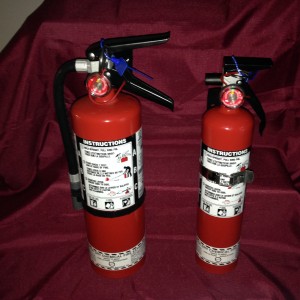Fire Fighting Equipment
 At Match-it Supplies Ltd., we have a wide variety of fire protection and fire-fighting products. Every home should have a fire extinguisher and fire plan on hand. Stop by today to get yours.
At Match-it Supplies Ltd., we have a wide variety of fire protection and fire-fighting products. Every home should have a fire extinguisher and fire plan on hand. Stop by today to get yours.
READ THE INSTRUCTIONS ON YOUR EXTINGUISHER FOR PROPER USE.
Create a picture in your mind that will reflect the instructions on the extinguisher: if there’s a fire, get everyone outside and ask a member of your family to call the fire department from a neighbour’s house. Only then should you permit yourself to fight a small fire. If the fire becomes large, get out. Close doors behind you to slow the spread of the fire.
THE ABCD’S OF PORTABLE FIRE EXTINGUISHERS:
A fire extinguisher is a storage container for an agent like water or chemicals. It is designed to put out a small fire, not a large one. Extinguishers are labelled ABC or D. Ensure you use the right extinguisher for the appropriate type of fire.
- Ordinary Combustibles – Fires started with paper, wood, drapes and upholstery require a Class A type extinguisher.
- Flammable and Combustible Liquids – Fires originating from fuel oil, gasoline, paint, grease in a frying pan, solvents and other flammable liquids require a Class B type extinguisher.
- Electrical Equipment – Fires started with wiring, overheated fuse boxes, conductors, and other electrical sources require a Class C type extinguisher.
- Metals – Certain metals such as magnesium and sodium require a special dry powder Class D type extinguisher.
A multi-purpose dry chemical labelled ABC puts out most types of fires: wood, paper, cloth, flammable liquids and electrical fires. If you intend to buy more than one, you may want to purchase a BC for the kitchen, an A for the living room and an ABC for the basement and garage.
BUYING AND MAINTAINING AN EXTINGUISHER:
- Extinguishers come in a dry chemical, foam, carbon dioxide, water, or Halon form. Whatever type you buy, it should be labelled by a nationally recognized testing laboratory.
- The higher the number rating on the extinguisher, the more fire it puts out. High rated extinguishers are often (not always) the heavier models. Ensure you can hold and operate the one you buy comfortably.
- Ask your dealer how to have your extinguisher serviced and inspected. Recharge it after ANY use. A partially used extinguisher might as well be empty.
- Extinguishers should be installed near an escape route and away from potential fire hazards.
LEARN HOW TO P-A-S-S-
- Pull the pin. Some units require the releasing of a lock latch, pressing a puncture lever, inversion or other motion.
- Aim the extinguisher nozzle (horn) at the base of the fire.
- Squeeze or press the handle.
- Sweep from side-to-side at the base of the fire and discharge the contents of the extinguisher.
Foam and water extinguishers require slightly different use. Read the instructions.
With files from Fire Prevention Canada
